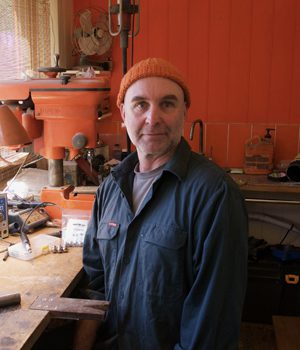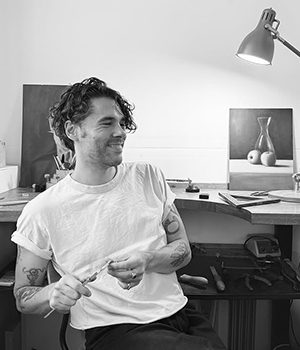Anita Crowther’s passion for lapidary
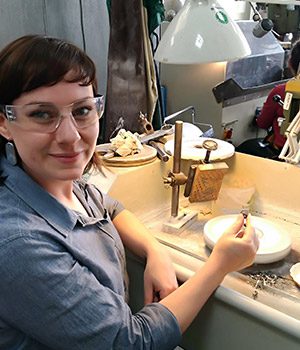 Anita Crowther‘s latest exhibition is titled Illuminate: a collection of jewellery that highlights Anita’s dedication to exploring the possibilities of lapidary. Anita recently visited a town in Germany to learn new (and old) techniques that inform her latest work. We asked the artist to share her experiences with us…
Anita Crowther‘s latest exhibition is titled Illuminate: a collection of jewellery that highlights Anita’s dedication to exploring the possibilities of lapidary. Anita recently visited a town in Germany to learn new (and old) techniques that inform her latest work. We asked the artist to share her experiences with us…
When did your passion for gems and minerals begin?
When I was around ten years old, my neighbor (who was also my age) showed me a little bag of tumbled stones. That was it. I was hooked. I started collecting from shops and gem fairs. I converted my cubby house into my ‘Gem Cave’ to display my growing collection of specimens. I would sit in there inspecting each piece and study each one in my books on gems and minerals. I was drawn into their miniature worlds and fascinated by their varied formations and origins. My father took me to join the Mordialloc Lapidary Club, where I began learning how to cut and polish stones. I would stand on an overturned drawer to reach the grinding wheels.
You recently travelled to Idar-Oberstein in Germany. Tell us a little about that …
Ever since I had heard about Idar-Oberstein many years ago I envisioned that one day I would go there. Located on the banks of the Nahe river in the south west of Germany, Idar-Oberstein is a world renowned historical center of stone cutting with a rich history of mining and lapidary dating back thousands of years. The area was originally mined for agate, jasper and quartz. Mechanized mining in the area started as early as the late 1400s. The stone cutting workshops were located along the river as the grinding wheels were powered by the energy from water wheels. During the 1800s when the deposits began to be depleted, stones were brought in from other countries such as Brazil to be cut and processed.
I sent a necklace there five years ago for inclusion in an agate exhibition, that was the first contact I made with the university. Last year my sister was living in Switzerland so I thought it would be a great opportunity to visit her and check out Idar-Oberstein. I looked into the university and found they held short summer courses in stone cutting and many other jewellery related skills. I stayed in the beautiful valley town for two weeks and took part in two different stone cutting courses.
What inspired you while you were there?
The two joint towns, Idar and Oberstein each have a wonderful gemstone and mineral museum that were very informative about the role of the town and examples of what the extremely skilled cutters produced for world wide use. From scientific instruments to African currency, cameos, carvings and jewels and even huge breathtaking quartz and agate bowls that would be transported to Parisian aristocracy. It really made me contemplate the human connection to stone and its varied roles and applications throughout history.
Other features include a castle and a church that is built into the rock of a mountain. Also an incredible historical chain making factory titled, the ‘Industrial Monument Jakob Bengel’ which holds an important place in the history of modern jewellery production.
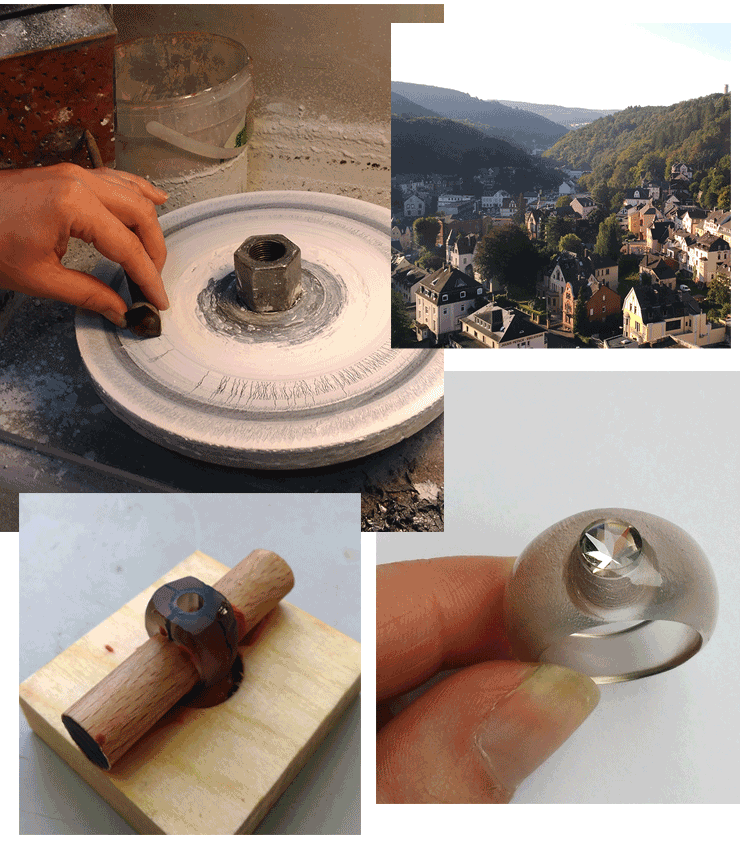
What did you learn on your visit?
It was so interesting to learn and try the traditional German method of faceting that hasn’t changed for four hundred years. Modern faceting machines have a jig where the stone is attached to an arm and an index wheel so you can see and adjust the exact angle of the facet you are cutting into the stone. The German method I tried involves a wooden block, covered in rows of holes. The height and the angle of the block is adjustable, the stone is attached to a wooden dowel and held by hand with the tip slotting into the appropriate hole. So essentially the person has to find the angle each time by the tilt and feel of their own hand. Incredible! Using this method I cut one large free form smoky quartz and the center stone of a ring I made entirely from one piece of smoky quartz which inspired the agate ring and earrings in my exhibition.
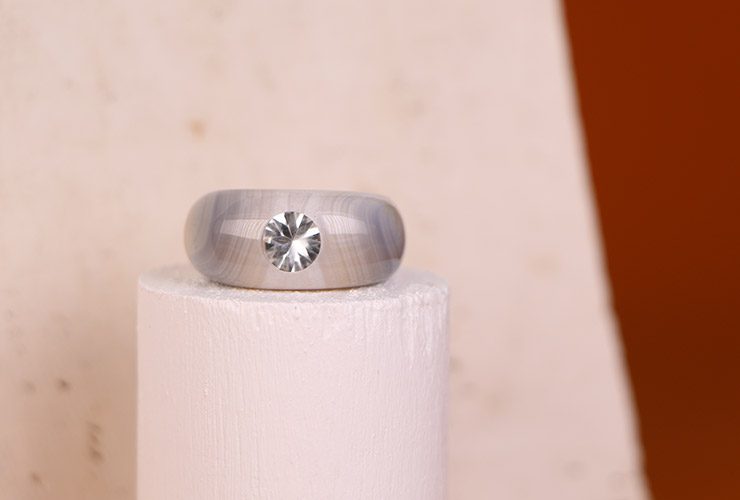
There was machinery and equipment that I had never used before so it was very exciting and opened my mind to many possibilities. There were very precise core drills that were so fine they could make thin stone tubes.
I also learned to experiment more and think about how minerals form and interact with each other. I made a series of little stone sculptures. These inspired the three new objects that are in the exhibition displayed with one that I made in Germany. These curiosities play with the idea of what is natural and draw from stones that are compositions of different minerals.
Where have did you sourced your stones for your exhibition work for ‘Illuminate’?
Some of the opals, agate and other stones I have collected over the years. I traveled to Lightning Ridge, Coober Pedy, Sapphire and Rubyvale in recent years for opal and sapphires that feature in the exhibition. The chalcedony and iolite in the exhibition I found in Germany. While there, I was granted access into some amazing wholesalers. It was as if all my Christmases had come at once! I had to buy a new carry-on suitcase just for rocks, which airport security always found interesting.
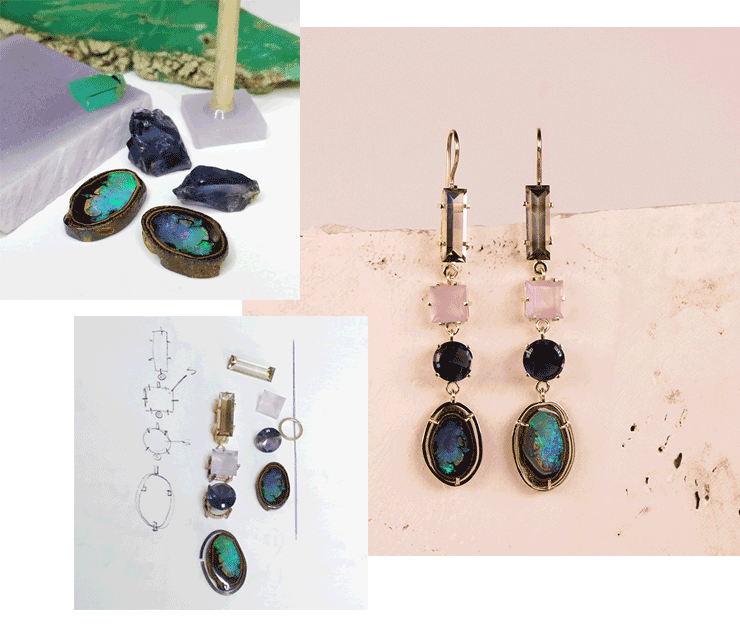
What do you love most about lapidary?
This might sound strange but there is an element of nostalgia about it for me, especially when I go back to the Mordialloc gem club. The smells of saw fluid, machine oil, ground rock, the sounds of the saw and the wheels. It has a personal timelessness that I get lost in. It is slow, patient work that becomes meditative.
The human act of working stone is such an age old process. Incorporating creativity into fashioning a material that is millions of years old to reveal such great inner beauty is a process that is very seductive, uplifting and rewarding.
Illuminate exhibits at e.g.etal until 28 September, 2019.
